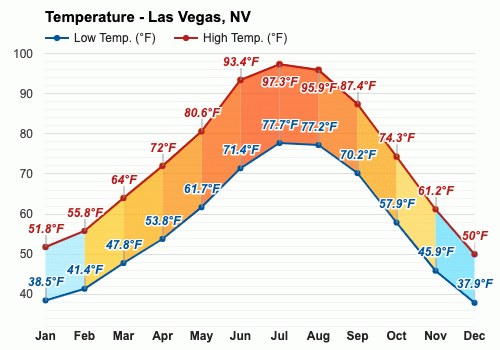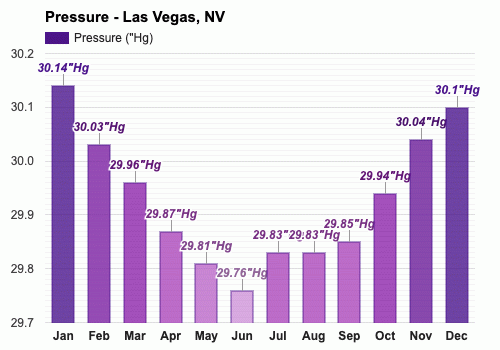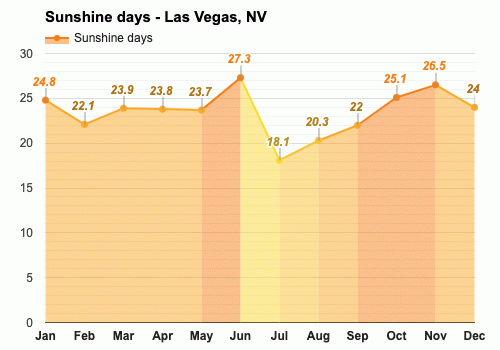Contents
- The climate of Las Vegas
- The best time to visit Las Vegas
- The worst time to visit Las Vegas
- Spring weather in Las Vegas
- Summer weather in Las Vegas
- Autumn weather in Las Vegas
- Winter weather in Las Vegas
- Weather in January
- Weather in February
- Weather in March
- Weather in April
- Weather in May
- Weather in June
- Weather in July
- Weather in August
- Weather in September
- Weather in October
- Weather in November
- Weather in December
- Frequently asked questions
- Average temperature
- Average pressure
- Average wind speed
- Average humidity
- Average rainfall
- Average rainfall days
- Average snowfall
- Average snowfall days
- Average daylight
- Average sunshine
- Average sunshine days
- Average UV index
- Average cloud cover
- Average visibility

Climate and monthly weather forecast
The climate of Las Vegas
Throughout the year, Las Vegas embraces an extensive variation in thermal conditions. Daytime temperatures embark on a journey from a low average of 51.8°F (11°C) in January to a scorching average of 97.3°F (36.3°C) in July. The story of night temperatures unfolds similarly, starting at 38.5°F (3.6°C) in January and peaking at 77.7°F (25.4°C) in July. This manifestation of desert climate witnesses relative humidity ranging from a low level of 15% in June to a peak of 48% in January, reflecting the region's overall dry nature.
Precipitation patterns in Las Vegas exhibit consistency with the desert climate type. Even though the elements of rainfall concentrate from 0.08" (2mm) in June to 0.87" (22mm) in July, this city witnesses days with rainfall from as low as 1.4 in June to a maximum of 8.3 in July. However, snowfall is a rare occurrence here, limited to slight amounts in January and December.
Unique weather phenomena include the city's impressive sunlight and sky clarity. With sunlit days in the count of 27.3 in June and daylight hours peaking at 14.6 in June and July, Las Vegas boasts of radiant sunshine and extended light hours, particularly beneficial for potential visitors.
The best time to visit Las Vegas
The worst time to visit Las Vegas
Spring weather in Las Vegas
Summer weather in Las Vegas
Autumn weather in Las Vegas
Winter weather in Las Vegas
Weather in January
Weather in February
Weather in March
Weather in April
Weather in May
Weather in June
Weather in July
Weather in August
Weather in September
Weather in October
Weather in November
Weather in December
Published by: Weather U.S. | About Us
Data Sources | Weather Forecasting & Climate
Frequently asked questions
What is the most humid month?
How many days does it rain?
When does it snow?
How much does it snow?
When does it snow the most?
When it does not snow?
When is Daylight Saving Time (DST)?
What is the least humid month?
What is the driest month?
When are the longest days?
What are the months with the highest UV index?
What is the warmest month?
What is the rainiest month?
What month has the most sunshine?
What are the coldest months in Las Vegas?
What is the month with the shortest days?
What is the month with the least sunshine?
When is the lowest UV index?

Average temperature
Las Vegas, NV
The warmest month (with the highest average high temperature) is July (97.3°F).
The month with the lowest average high temperature is December (50°F).
The month with the highest average low temperature is July (77.7°F).
The coldest month (with the lowest average low temperature) is December (37.9°F).

Average pressure
Las Vegas, NV
- Average pressure in January:
30.14"Hg - Average pressure in February:
30.03"Hg - Average pressure in March:
29.96"Hg - Average pressure in April:
29.87"Hg - Average pressure in May:
29.81"Hg - Average pressure in June:
29.76"Hg
- Average pressure in July:
29.83"Hg - Average pressure in August:
29.83"Hg - Average pressure in September:
29.85"Hg - Average pressure in October:
29.94"Hg - Average pressure in November:
30.04"Hg - Average pressure in December:
30.1"Hg
The month with the highest atmospheric pressure is January (30.14"Hg).
The month with the lowest atmospheric pressure is June (29.76"Hg).

Average wind speed
Las Vegas, NV
- Average wind speed in January:
5.5mph - Average wind speed in February:
6.4mph - Average wind speed in March:
7.7mph - Average wind speed in April:
8.5mph - Average wind speed in May:
8.1mph - Average wind speed in June:
8.2mph
- Average wind speed in July:
6.9mph - Average wind speed in August:
6.7mph - Average wind speed in September:
6.4mph - Average wind speed in October:
6.3mph - Average wind speed in November:
5.8mph - Average wind speed in December:
5.8mph
The windiest month (with the highest average wind speed) is April (8.5mph).
The calmest month (with the lowest average wind speed) is January (5.5mph).

Average humidity
Las Vegas, NV
The month with the highest relative humidity is January (48%).
The month with the lowest relative humidity is June (15%).

Average rainfall
Las Vegas, NV
- Average rainfall in January:
0.55" - Average rainfall in February:
0.63" - Average rainfall in March:
0.39" - Average rainfall in April:
0.31" - Average rainfall in May:
0.24" - Average rainfall in June:
0.08"
- Average rainfall in July:
0.87" - Average rainfall in August:
0.83" - Average rainfall in September:
0.51" - Average rainfall in October:
0.47" - Average rainfall in November:
0.47" - Average rainfall in December:
0.67"
The wettest month (with the highest rainfall) is July (0.87").
The driest month (with the least rainfall) is June (0.08").

Average rainfall days
Las Vegas, NV
- Average rainfall days in January:
4.5 days - Average rainfall days in February:
4.9 days - Average rainfall days in March:
6.3 days - Average rainfall days in April:
5.2 days - Average rainfall days in May:
3.7 days - Average rainfall days in June:
1.4 days
- Average rainfall days in July:
8.3 days - Average rainfall days in August:
5.9 days - Average rainfall days in September:
5.3 days - Average rainfall days in October:
4.2 days - Average rainfall days in November:
2.7 days - Average rainfall days in December:
5.1 days
The month with the highest number of rainy days is July (8.3 days).
The month with the least rainy days is June (1.4 days).

Average snowfall
Las Vegas, NV
The month with the highest snowfall is February (0.16").
The months with the least snowfall are March, April, May, June, July, August, September, October and November (0").

Average snowfall days
Las Vegas, NV
- Average snowfall days in January:
0.2 days - Average snowfall days in February:
0.3 days - Average snowfall days in March:
0 days - Average snowfall days in April:
0 days - Average snowfall days in May:
0 days - Average snowfall days in June:
0 days
- Average snowfall days in July:
0 days - Average snowfall days in August:
0 days - Average snowfall days in September:
0 days - Average snowfall days in October:
0 days - Average snowfall days in November:
0 days - Average snowfall days in December:
0.2 days
The month with the highest number of snowfall days is February (0.3 days).
The months with the least snowfall days are March, April, May, June, July, August, September, October and November (0 days).

Average daylight / Average sunshine
Las Vegas, NV
- Average daylight in January:
10h and 0min - Average daylight in February:
10h and 5min - Average daylight in March:
12h and 0min - Average daylight in April:
13h and 1min - Average daylight in May:
14h and 1min - Average daylight in June:
14h and 4min
- Average daylight in July:
14h and 2min - Average daylight in August:
13h and 3min - Average daylight in September:
12h and 2min - Average daylight in October:
11h and 2min - Average daylight in November:
10h and 2min - Average daylight in December:
9h and 4min
The month with the longest days is June (Average daylight: 14h and 36min).
The month with the shortest days is December (Average daylight: 9h and 42min).
- Average sunshine in January:
7h and 1min - Average sunshine in February:
7h and 1min - Average sunshine in March:
8h and 5min - Average sunshine in April:
11h and 2min - Average sunshine in May:
11h and 5min - Average sunshine in June:
12h and 1min
- Average sunshine in July:
12h and 0min - Average sunshine in August:
12h and 1min - Average sunshine in September:
10h and 2min - Average sunshine in October:
9h and 3min - Average sunshine in November:
7h and 2min - Average sunshine in December:
7h and 1min
The month with the most sunshine is August (Average sunshine: 12h and 12min).
The month with the least sunshine is December (Average sunshine: 7h and 6min).

Average sunshine days
Las Vegas, NV
- Average sunshine days in January:
24.8 days - Average sunshine days in February:
22.1 days - Average sunshine days in March:
23.9 days - Average sunshine days in April:
23.8 days - Average sunshine days in May:
23.7 days - Average sunshine days in June:
27.3 days
- Average sunshine days in July:
18.1 days - Average sunshine days in August:
20.3 days - Average sunshine days in September:
22 days - Average sunshine days in October:
25.1 days - Average sunshine days in November:
26.5 days - Average sunshine days in December:
24 days
The month with the most sunshine days is June (27.3 days).
The month with the least sunshine days is July (18.1 days).

Average UV index
Las Vegas, NV
The months with the highest UV index are June and July (UV index 8).
The month with the lowest UV index is December (UV index 2).

Average cloud cover
Las Vegas, NV
The month with the most cloud cover is December (Cloud cover 20).
The months with the least cloud cover are June and August (Cloud cover 6).

Average visibility
Las Vegas, NV
The months with the highest visibility are January, February, March, April, May, June, July, August, September, October, November and December (6mi).
The months with the lowest visibility are January, February, March, April, May, June, July, August, September, October, November and December (6mi).